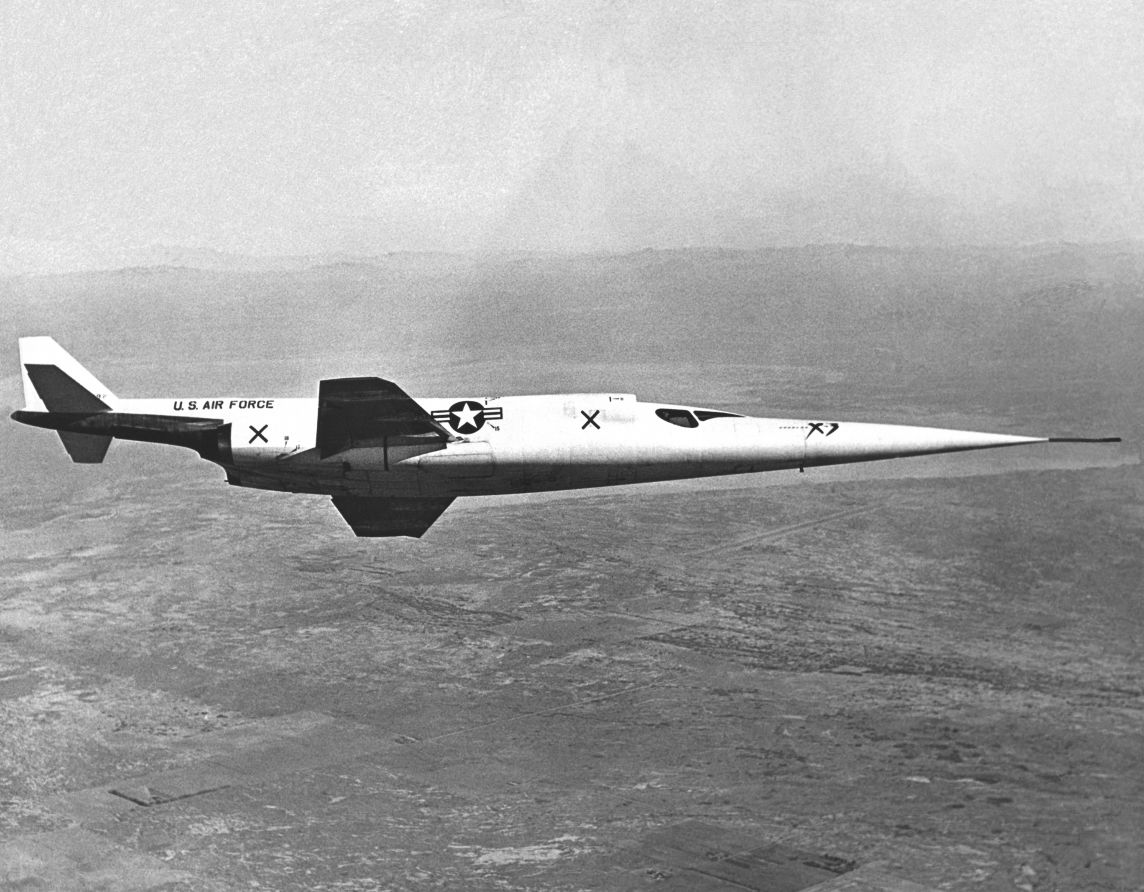File:Douglas X-3 NASA E-17348.jpg

Original file (3,000 × 2,143 pixels, file size: 3.08 MB, MIME type: image/jpeg)
This file is from Wikimedia Commons and may be used by other projects. The description on its file description page there is shown below.
Summary
| DescriptionDouglas X-3 NASA E-17348.jpg |
English: This in-flight NACA High-Speed Flight Station photograph of the X-3 Stiletto illustrates the aircraft’s long slender fuselage and the small wings. The X-3 Stiletto was a single-place jet-powered research aircraft manufactured by the Douglas Aircraft Company. The X-3's primary mission was to investigate the design features of an aircraft suitable for sustained supersonic speeds, which included the first use of titanium in major airframe components. It was delivered to the NACA High-Speed Flight Station in August of 1954 after some Douglas and Air Force evaluation testing. |
| Date |
1950s date QS:P,+1950-00-00T00:00:00Z/8 |
| Source | https://www.dfrc.nasa.gov/Gallery/Photo/X-3/Large/E-17348.jpg |
| Author | NASA |
This image or video was catalogued by Armstrong Flight Research Center of the United States National Aeronautics and Space Administration (NASA) under Photo ID: E-17348. This tag does not indicate the copyright status of the attached work. A normal copyright tag is still required. See Commons:Licensing. Other languages:
Afrikaans ∙ العربية ∙ беларуская (тарашкевіца) ∙ български ∙ Bahaso Jambi ∙ català ∙ čeština ∙ dansk ∙ Deutsch ∙ English ∙ español ∙ فارسی ∙ français ∙ galego ∙ magyar ∙ հայերեն ∙ Bahasa Indonesia ∙ italiano ∙ 日本語 ∙ македонски ∙ മലയാളം ∙ Nederlands ∙ polski ∙ português ∙ русский ∙ sicilianu ∙ slovenščina ∙ Türkçe ∙ українська ∙ 简体中文 ∙ 繁體中文 ∙ +/− |
Licensing
| Public domainPublic domainfalsefalse |
| This file is in the public domain in the United States because it was solely created by NASA. NASA copyright policy states that "NASA material is not protected by copyright unless noted". (See Template:PD-USGov, NASA copyright policy page or JPL Image Use Policy.) |  | |
 |
Warnings:
|
Captions
Items portrayed in this file
depicts
image/jpeg
File history
Click on a date/time to view the file as it appeared at that time.
| Date/Time | Thumbnail | Dimensions | User | Comment | |
|---|---|---|---|---|---|
| current | 12:41, 6 July 2024 |  | 3,000 × 2,143 (3.08 MB) | wikimediacommons>Caddyshack01 | Cropped 20 % vertically, 20 % areawise using CropTool with lossless mode. |
File usage
The following 2 pages use this file:
Metadata
This file contains additional information, probably added from the digital camera or scanner used to create or digitize it.
If the file has been modified from its original state, some details may not fully reflect the modified file.
| JPEG file comment | NASA Dryden Flight Research Center Photo Collection
http://www.dfrc.nasa.gov/gallery/photo/index.html NASA Photo: E-17348 Date: Early 1950's Photo by: NACA/NASA In-flight Photo of the X-3, which Made Significant Contributions to Knowledge about Inertial Coupling This in-flight NACA High-Speed Flight Station photograph of the X-3 Stiletto illustrates the aircraft’s long slender fuselage and the small wings. The X-3 Stiletto was a single-place jet aircraft with a slender fuselage and a long tapered nose, manufactured by the Douglas Aircraft Company. The X-3's primary mission was to investigate the design features of an aircraft suitable for sustained supersonic speeds, which included the first use of titanium in major airframe components. It was delivered to the NACA High-Speed Flight Station in August of 1954 after some Douglas and Air Force evaluation testing. The Douglas X-3, known as the Stiletto, was built to investigate the design of an aircraft suitable for sustained supersonic speeds. The X-3 was intended for sustained flight research above Mach 2, but was hampered by use of underpowered Westinghouse J34 turbojet engines which could not power the aircraft past Mach 1 in level flight. This aircraft was built by the Douglas Aircraft Company. <p> The X-3 had, perhaps, the most highly refined supersonic airframe of its day as well as other important advances including one of the first machined structures. It included the first use of titanium in major airframe components. Its long fuselage gave the Stiletto a high-fineness ratio and a low-aspect ratio (the ratio of the wing’s span to its chord; in other words, it was short and stubby). Despite this refined configuration, the maximum speed it attained was Mach 1.21, during a dive. The general consensus was that the aircraft was sluggish and extremely underpowered. The X-3 also demonstrated coupling instability during abrupt rolling maneuvers, which could cause it to go wildly out of control, as happened on a flight on October 27, 1954, with National Advisory Committee for Aeronautics (NACA) pilot Joe Walker at the controls. <p> The principle contribution of the X-3 was its data on inertial coupling (roll divergence)--a tendency to diverge from the intended flight path. The aircraft also shed its small tires routinely, leading to a revision of the design criteria for tires used on high-speed aircraft. This aircraft flew 20 times between 1954 and 1956 at the NACA High-Speed Flight Station (predecessor of NASA’s Dryden Flight Research Center, Edwards, California). Joe Walker was the pilot for all 20 of these missions. The X-3’s first flight was in October 1952 with Douglas test pilot Bill Bridgeman in the cockpit. The Air Force completed a brief evaluation of the airplane in 1953 and 1954 before turning it over to the NACA in the summer of 1954. |
|---|
